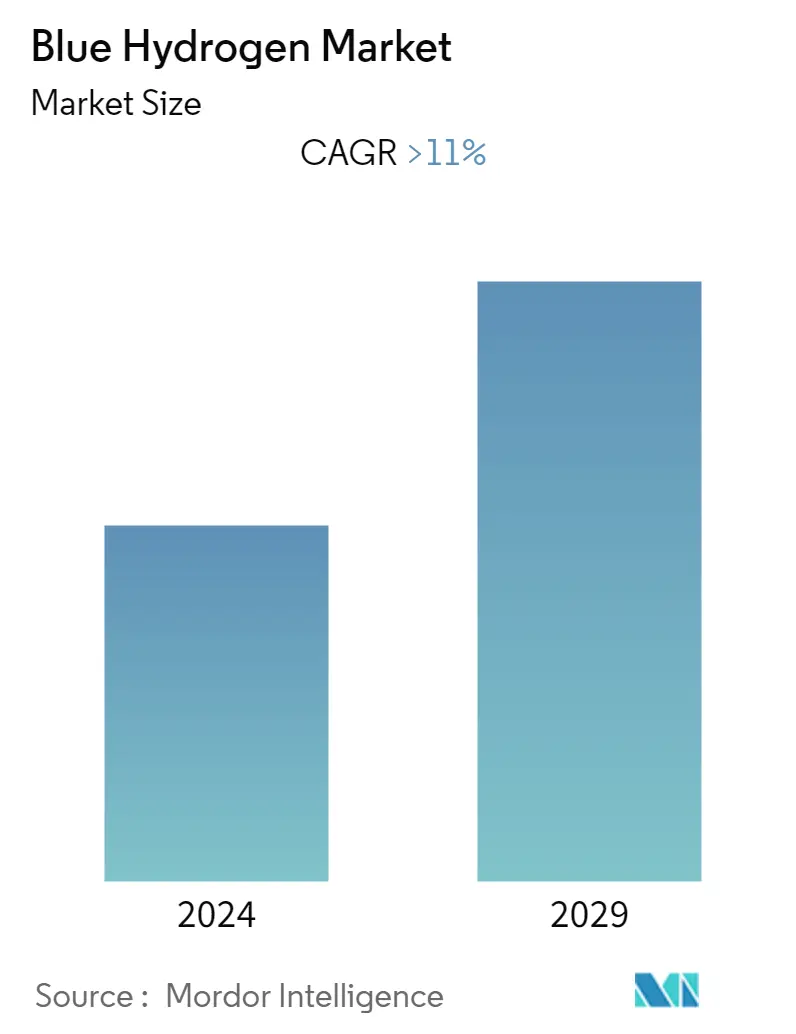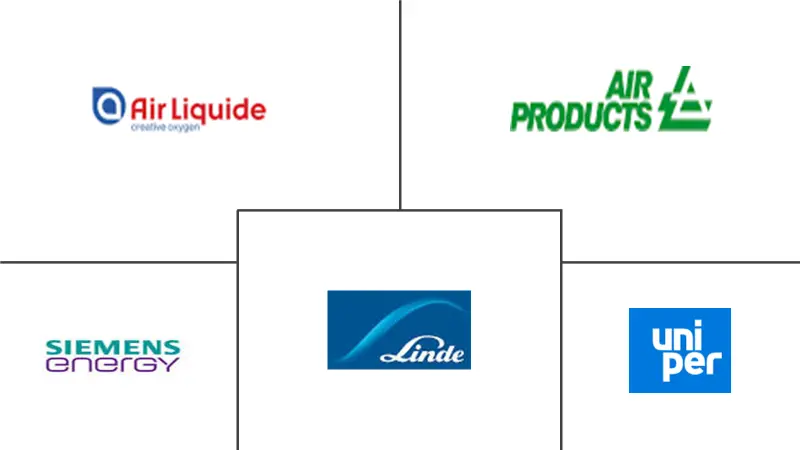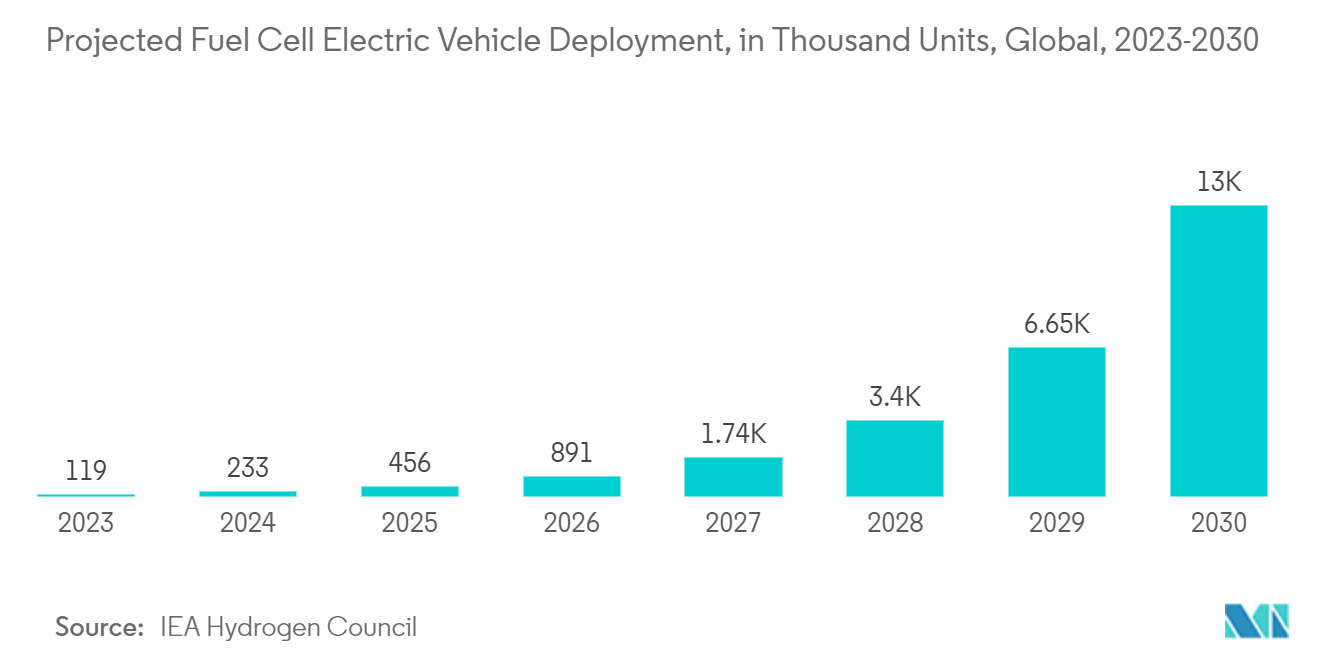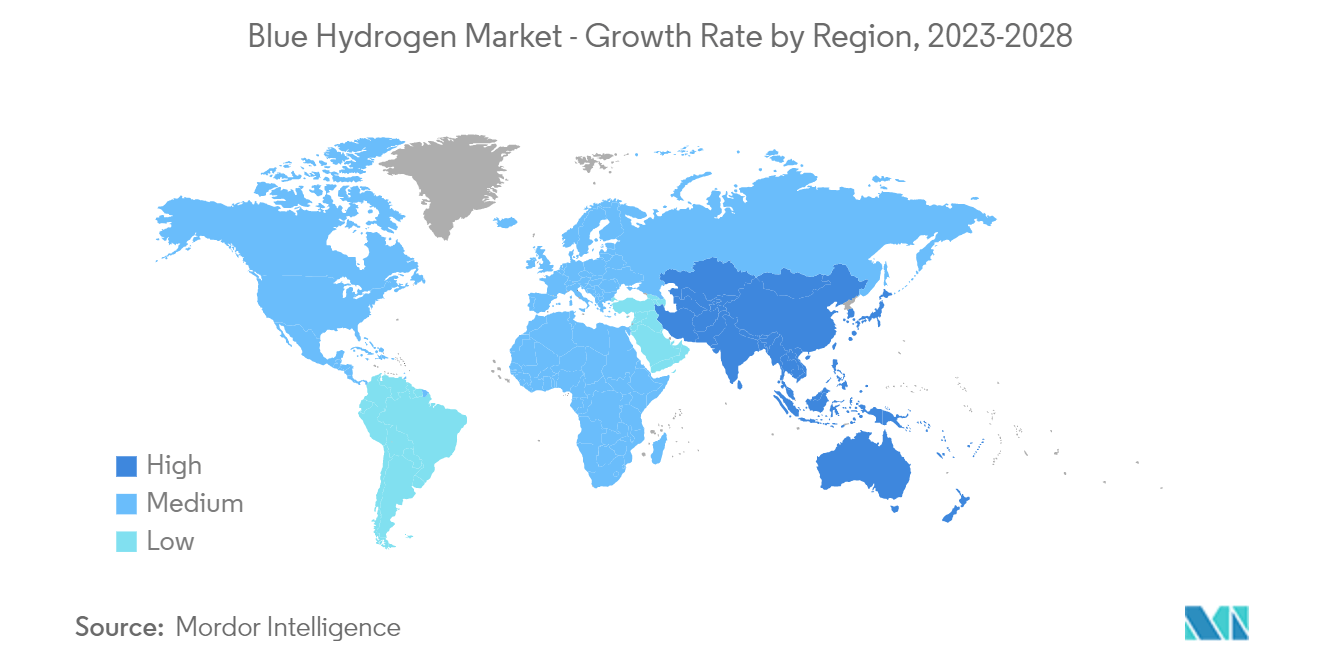Blue Hydrogen Market Size

| Study Period | 2019 - 2029 |
| Base Year For Estimation | 2023 |
| CAGR | > 11.00 % |
| Fastest Growing Market | Asia-Pacific |
| Largest Market | North America |
| Market Concentration | Medium |
Major Players
*Disclaimer: Major Players sorted in no particular order |
Blue Hydrogen Market Analysis
The global blue hydrogen market is poised to grow at a CAGR of over 11% during the forecast period.
COVID-19 moderately impacted the overall blue hydrogen industry growth due to the temporary production halt. However, the increased demand for blue hydrogen in transportation propelled the industry's growth.
- The surging application of blue hydrogen in fuel cell electric vehicles and the rising demand from the chemical sector are major factors driving the demand for blue hydrogen.
- Loss of energy during hydrogen production may hinder the overall industry growth.
- Rising government initiatives to shift towards clean energy sources will likely offer new growth opportunities during the forecast period.
- North America dominated the blue hydrogen market due to the increasing fuel-cell electric vehicle production.
Blue Hydrogen Market Trends
Surging Application of Blue Hydrogen in Fuel Cell Electric Vehicles
- Blue hydrogen can reduce CO2 emissions by displacing fossil fuels such as natural gas in domestic and industrial applications and oil in transport. Blue hydrogen includes the added advantage of allowing renewable and nuclear power to displace unabated fossil fuel electricity generation in electricity grids.
- Blue hydrogen can be the lowest-cost option to help decarbonize industrial heating, residential heating in extremely cold climates, and heavy-duty vehicles.
- The rising GHG emission from vehicles will likely boost blue hydrogen adoption. The transportation sector is responsible for 28% of greenhouse gas emissions. Therefore, electric vehicles have gained popularity because they emit zero emissions into the environment, low refueling costs, and maintenance costs. Hydrogen-powered fuel cells are pollution-free and can have two to three times the efficiency of traditional combustion technologies.
- China had the most sales in 2021, tripling those of 2020 with 3.3 million, followed by Europe with 2.3 million sales, an increase from 1.4 million in 2020. In 2021, 630000 electric vehicles were sold in the United States, doubling their market share to 4.5%.
- By the end of June 2021, more than 40,000 FCEVs were on the road worldwide. The fuel cell usage in electric vehicles, where the battery is recharged by hydrogen present in a tank, is introduced to promote the process of moving toward sustainable mobility. Compared to lithium-ion batteries, hydrogen FCEVs offer a substantial range advantage while being lighter and taking up less space. It is because hydrogen FCEVs have a far higher energy storage density.
- At the beginning of 2021, some 31,000 fuel cell electric vehicles (FCEVs) were recorded worldwide. Projections indicate a compound annual growth rate of some 95.4%5 between 2020 and 2030, with the global FCEV fleet reaching approximately 13 million units in 2030.
- Therefore, the factors above are projected to boost the consumption of blue hydrogen in FCEVs.

North America Expected to Dominate the Market
- North America is the largest consumer of blue hydrogen owing to the increased blue hydrogen application in transportation, petroleum refineries, and power generation industries.
- The chemical industry is a critical sector in developing innovative solutions to enable the shift toward sustainability and becoming net zero. Net-zero targets can be achieved through energy efficiency, bio-based feedstock, and closing material loops, stressing the need for other solutions such as hydrogen, carbon capture, and electrification in the chemical industry. About 10 million tons of hydrogen is used mainly as feedstock for producing ammonia and methanol.
- The growing chemical industry in the United States is likely to propel the application of blue hydrogen. The United States is the world's second-largest national producer of chemical products after China. In 2021, chemical shipments from the United States were worth USD 769 billion.
- Furthermore, hydrogen is commonly used in hydrocracking to create petroleum products, including gasoline and diesel. Refineries in the United States use 1.33 billion SCF of hydrogen each day to remove sulfur compounds from diesel fuel, gasoline, and other products.
- In North America, oil refining capacity amounted to around 21.4 million barrels per day in 2021, slightly down from 21.8 million barrels daily in the previous year. Between 2009 and 2021, North America's oil refinery capacity grew by 417 thousand barrels daily.
- Moreover, the United States uses many energy sources and technologies to generate electricity. The three major energy categories for electricity generation are fossil fuels (coal, natural gas, and petroleum), nuclear energy, and renewable energy sources.
- Canada will grow a domestic hydrogen economy, providing economic and environmental benefits nationally, lowering emissions in sectors like transportation, and positioning hydrogen as a key component of our net-zero future. For instance, in June 2022, Vancouver-based zero-emission vehicle company First Hydrogen announced that it would start testing its first demonstrator fuel cell electric vehicle (FCEV).
- Additionally, in March 2021, the Canadian Minister of Natural Resources announced that the Canadian Hydrogen and Fuel Cell Association (CHFCA) would receive USD 46,000 in funding to help promote the advantages of hydrogen fuel cell electric vehicles (FCEV), such as quick refueling times that make them a great choice for the bus and trucking industries.
- These trends mentioned above are the major factors driving the demand for blue hydrogen in the North American region.

Blue Hydrogen Industry Overview
The global blue hydrogen market is partially consolidated, with a few major players dominating a significant portion of the market. Some major companies are Siemens Energy, Air Products Inc., Air Liquide, Linde plc, and Uniper SE, among others (not in any particular order).
Blue Hydrogen Market Leaders
-
Air Liquide
-
Air Products Inc.
-
Siemens Energy
-
Linde plc
-
Uniper SE
*Disclaimer: Major Players sorted in no particular order

Blue Hydrogen Market News
- February 2023: Linde announced plans to build a USD 1.8 billion blue hydrogen facility on the Texas Gulf Coast designed to supply ammonia production. The company plans to begin production in 2025. The Linde facility will produce blue hydrogen using auto thermal reforming, which produces hydrogen by reacting methane with oxygen and steam, paired with carbon capture.
- February 2023: Linde signed a long-term agreement to supply clean hydrogen and other industrial gases to OCI's new world-scale blue ammonia plant in Beaumont, Texas.
- April 2022: Uniper signed an agreement with Shell to progress plans to produce blue hydrogen at Uniper's Killingholme power station site in East England. The Humber Hub Blue Project includes plans for a blue hydrogen production facility with a capacity of up to 720 megawatts (MW), using gas reformation technology with carbon capture and storage (CCS).
Blue Hydrogen Market Report - Table of Contents
1. INTRODUCTION
1.1 Study Assumptions and Market Definition
1.2 Scope of the Study
2. RESEARCH METHODOLOGY
3. EXECUTIVE SUMMARY
4. MARKET DYNAMICS
4.1 Market Drivers
4.1.1 Surging Application of Blue Hydrogen in Fuel Cell Electric Vehicles
4.1.2 Rising Demand from the Chemical Sector
4.2 Market Restraints
4.2.1 Loss of Energy During Hydrogen Production
4.2.2 Other Market Restraints
4.3 Industry Value-Chain Analysis
4.4 Porter's Five Forces Analysis
4.4.1 Bargaining Power of Suppliers
4.4.2 Bargaining Power of Consumers
4.4.3 Threat of New Entrants
4.4.4 Threat of Substitute Products and Services
4.4.5 Degree of Competition
4.5 Technological Snapshot
5. MARKET SEGMENTATION (Market Size in Volume)
5.1 End-user Industry
5.1.1 Refining
5.1.2 Chemicals
5.1.3 Iron and Steel
5.1.4 Transportation
5.1.5 Other End-user Industries
5.2 Geography
5.2.1 Asia-Pacific
5.2.1.1 China
5.2.1.2 India
5.2.1.3 Japan
5.2.1.4 South Korea
5.2.1.5 Rest of Asia-Pacific
5.2.2 North America
5.2.2.1 United States
5.2.2.2 Canada
5.2.2.3 Mexico
5.2.3 Europe
5.2.3.1 Germany
5.2.3.2 United Kingdom
5.2.3.3 France
5.2.3.4 Italy
5.2.3.5 Rest of Europe
5.2.4 Rest of the World
5.2.4.1 South America
5.2.4.2 Middle-East and Africa
6. COMPETITIVE LANDSCAPE
6.1 Mergers and Acquisitions, Joint Ventures, Collaborations, and Agreements
6.2 Market Share(%) Analysis**/Market Ranking Analysis
6.3 Strategies Adopted by Leading Players
6.4 Company Profiles
6.4.1 ATCO Ltd.
6.4.2 Air Liquide
6.4.3 Air Products Inc.
6.4.4 Cummins Inc.
6.4.5 CertifHy Canada Inc.
6.4.6 Equinor ASA
6.4.7 Linde plc
6.4.8 Royal Dutch Shell Plc
6.4.9 Reliance Industries Ltd.
6.4.10 Suncor Energy Inc.
6.4.11 Siemens Energy
6.4.12 Saudi Aramco
6.4.13 Toshiba Energy Systems & Solutions Corp.
6.4.14 Uniper SE
6.4.15 Xebec Adsorption Inc.
- *List Not Exhaustive
7. MARKET OPPORTUNITIES AND FUTURE TRENDS
7.1 Rising Government Initiatives to Shift Towards Clean Energy Sources
Blue Hydrogen Industry Segmentation
Blue hydrogen is an industry term for hydrogen produced from natural gas and supported by carbon capture and storage. The market is segmented into end-user industry and geography. By end-user industry, the market is segmented into refining, chemicals, iron and steel, transportation, and other end-user industries. The report also covers the market size and forecasts for the green hydrogen market in 11 countries across major regions. The market sizing and forecasts for each segment have been done based on volume (kilotons).
| End-user Industry | |
| Refining | |
| Chemicals | |
| Iron and Steel | |
| Transportation | |
| Other End-user Industries |
| Geography | |||||||
| |||||||
| |||||||
| |||||||
|
Blue Hydrogen Market Research FAQs
What is the current Blue Hydrogen Market size?
The Blue Hydrogen Market is projected to register a CAGR of greater than 11% during the forecast period (2024-2029)
Who are the key players in Blue Hydrogen Market?
Air Liquide, Air Products Inc., Siemens Energy, Linde plc and Uniper SE are the major companies operating in the Blue Hydrogen Market.
Which is the fastest growing region in Blue Hydrogen Market?
Asia-Pacific is estimated to grow at the highest CAGR over the forecast period (2024-2029).
Which region has the biggest share in Blue Hydrogen Market?
In 2024, the North America accounts for the largest market share in Blue Hydrogen Market.
What years does this Blue Hydrogen Market cover?
The report covers the Blue Hydrogen Market historical market size for years: 2019, 2020, 2021, 2022 and 2023. The report also forecasts the Blue Hydrogen Market size for years: 2024, 2025, 2026, 2027, 2028 and 2029.
Blue Hydrogen Industry Report
Statistics for the 2024 Blue Hydrogen market share, size and revenue growth rate, created by Mordor Intelligence™ Industry Reports. Blue Hydrogen analysis includes a market forecast outlook to 2029 and historical overview. Get a sample of this industry analysis as a free report PDF download.



